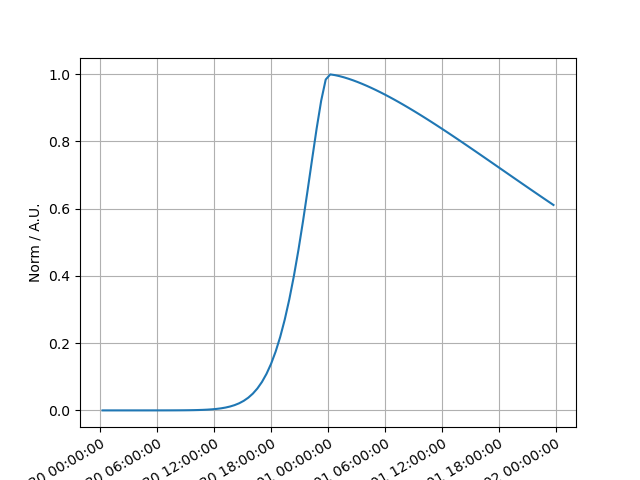Note
Click here to download the full example code
Generalized Gaussian temporal model#
This model parametrises a generalized Gaussian time model.
\[ \begin{align}\begin{aligned}F(t) = exp( - 0.5 * (\frac{|t - t_{\rm{ref}}|}{t_{\rm{rise}}}) ^ {1 / \eta}) \text{ for } t < t_{\rm{ref}}\\F(t) = exp( - 0.5 * (\frac{|t - t_{\rm{ref}}|}{t_{\rm{decay}}}) ^ {1 / \eta}) \text{ for } t > t_{\rm{ref}}\end{aligned}\end{align} \]
Example plot#
Here is an example plot of the model:
from astropy import units as u
from astropy.time import Time
from astropy.units import Quantity
import matplotlib.pyplot as plt
from gammapy.modeling.models import (
GeneralizedGaussianTemporalModel,
Models,
PowerLawSpectralModel,
SkyModel,
)
t_rise = Quantity(0.1, "d")
t_decay = Quantity(1, "d")
eta = Quantity(2 / 3, "")
t_ref = Time("2020-10-01")
time_range = [t_ref - 1 * u.d, t_ref + 1 * u.d]
gen_gaussian_model = GeneralizedGaussianTemporalModel(
t_ref=t_ref.mjd * u.d, t_rise=t_rise, t_decay=t_decay, eta=eta
)
gen_gaussian_model.plot(time_range)
plt.grid(which="both")

YAML representation#
Here is an example YAML file using the model:
model = SkyModel(
spectral_model=PowerLawSpectralModel(),
temporal_model=gen_gaussian_model,
name="generalized_gaussian_model",
)
models = Models([model])
print(models.to_yaml())
Out:
components:
- name: generalized_gaussian_model
type: SkyModel
spectral:
type: PowerLawSpectralModel
parameters:
- name: index
value: 2.0
- name: amplitude
value: 1.0e-12
unit: cm-2 s-1 TeV-1
- name: reference
value: 1.0
unit: TeV
frozen: true
temporal:
type: GeneralizedGaussianTemporalModel
parameters:
- name: t_ref
value: 59123.0
unit: d
- name: t_rise
value: 0.1
unit: d
- name: t_decay
value: 1.0
unit: d
- name: eta
value: 0.6666666666666666